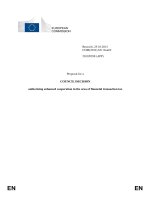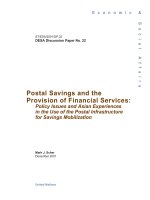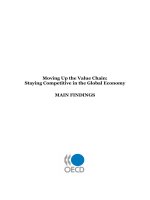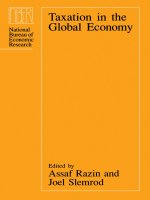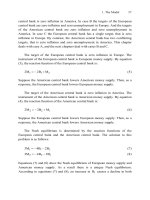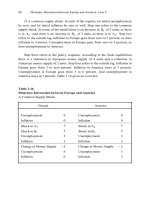fumagalli & mezzadra - crisis in the global economy; financial markets, social struggles, and new political scenarios (2010)
Bạn đang xem bản rút gọn của tài liệu. Xem và tải ngay bản đầy đủ của tài liệu tại đây (2.57 MB, 304 trang )
CRISIS IN THE
GLOBAL ECONOMY
CRISIS GLOBAL-5_Crisis-temp 11/15/09 2:00 PM Page 1
SEMIOTEXT(E) ACTIVE AGENTS SERIES
© 2010 by Semiotext(e) and Ombre Corte.
All rights reserved. No part of this book may be reproduced, stored in a
retrieval system, or transmitted by any means, electronic, mechanical, photo-
copying, recording, or otherwise, without prior permission of the publisher.
Published by Semiotext(e)
2007 Wilshire Blvd., Suite 427, Los Angeles, CA 90057
www.semiotexte.com
Special thanks to
Andrew Drabkin, John Ebert, and Jason Smith.
Cover art by Moyra Davey, Copperhead No ??, 20??.
Courtesy of the artist and ???.
Design by Hedi El Kholti
ISBN: 978-1-58435-087-3
Distributed by The MIT Press, Cambridge, Mass. and London, England
Printed in the United States of America
CRISIS GLOBAL-5_Crisis-temp 11/15/09 2:00 PM Page 2
<e>
Edited by Andrea Fumagalli and Sandro Mezzadra
Translated by Jason Francis Mc Gimsey
CRISIS IN THE
GLOBAL ECONOMY
FINANCIAL MARKETS, SOCIAL STRUGGLES,
AND NEW POLITICAL SCENARIOS
CRISIS GLOBAL-5_Crisis-temp 11/15/09 2:00 PM Page 3
CRISIS GLOBAL-5_Crisis-temp 11/15/09 2:00 PM Page 4
Contents
Introduction
Sandro Mezzadra
The Violence of Financial Capitalism
Christian Marazzi
The Global Economic Crisis and Socioeconomic Governance
Andrea Fumagalli
The Crisis of the Law of Value and the Becoming-Rent of Profit
Carlo Vercellone
Financialization as Biopower
Stefano Lucarelli
On the Threshold of Capital, At The Thresholds of the Common
Federico Chicchi
New Economy, Financialization and Social Production in the Web 2.0
Tiziana Terranova
Cognitive Capitalism and the Financialization of Economic Systems
Bernard Paulré
Global Crisis – Global Proletarianization—Counter-perspectives
Karl Heinz Roth
Nothing Will Ever Be The Same
Ten theses on the financial crisis
Postface
Antonio Negri
Notes
About the Authors
7
17
61
85
119
139
153
171
197
237
263
273
299
CRISIS GLOBAL-5_Crisis-temp 11/15/09 2:00 PM Page 5
CRISIS GLOBAL-5_Crisis-temp 11/15/09 2:00 PM Page 6
Introduction
1. The passion for knowledge, the impatient desire to understand
the world in order to change it: certainly there is also a lot of “rea-
son” in UniNomade, particularly in this volume that inaugurates
its book series. But it is the “emotional temperature” of the discus-
sions that animate the network that constitute its principle “added
value.” For four years now (the first UniNomade seminar, dedicat-
ed to “War and Democracy,” was held in Padua on January 29th
and 30th, 2005),
1
at least three generations of researchers and
activists raised in the footsteps of the tradition of Italian workerism
2
periodically meet in seminars which see the participation of hun-
dreds of people. Europe and social networking, the new forms
assumed by the metropolis and governance, the “Institutions of the
Common,” the relations between contemporary art and activism,
the metamorphoses of labor and those of the university; these are
some of the themes that have been addressed over these last few
years in a continuous dialogue with analogous experiences that are
going on in five different continents.
Our point of departure the awareness that we live in an era in
which the very statute of knowledges is being radically modified,
imposing (as the latest “Anomalous Wave movement in Italy has
demonstrated in an extraordinarily effective way) a rethinking of
S
andro Mezzadra
7
CRISIS GLOBAL-5_Crisis-temp 11/15/09 2:00 PM Page 7
the relation between knowledge production and classic (academic
and political) institutional spaces that had previously enjoyed a
monopoly over it.
3
When knowledge—not only “technical” knowl-
edge but “humanistic” knowledge too—becomes an immediately
productive force, the critique of knowledges is nothing other than
the critique of the political economy. When universities become
essential nodes of metropolitan production, lingering over the
defense of its “liberty” in a traditional sense isn t worth while.
When the most fundamental conflicts in the development of class
struggle are carried out on the terrain of knowledges, there is no
party that can vindicate a primacy in the production of theory and
the privileges of the “battle of ideas” are no longer reserved to
“organic intellectuals.”
We are schematically and problematically alluding to prodi-
gious transformations here. We don’t have any simple solutions to
propose, only a sense of urgency and the conviction that it is nec-
essary to create new spaces and new institutions within which
uncharted relations between knowledge production, political prac-
tices and struggle development can be explored. UniNomade is a
first step in this direction: seminar participation and project con-
struction with of hundreds of social movement activists, not as
subjects “to be educated” but as full fledged protagonists, is there-
fore a qualifying element of the experience that we have lived over
these last few years and that we will continue living, expanding and
making evermore effective in the near future. A book series, which
this work inaugurates is the first tool that we are adopting to extend
the area of our discussion, to enter in a more direct and incisive
way into public debate in order to look for interlocutors and allies.
We come, as we’ve said, from the great tradition of revolution-
ary Italian workerism, and our work is collocated within what is
8 / Crisis in the Global Economy
CRISIS GLOBAL-5_Crisis-temp 11/15/09 2:00 PM Page 8
now, in the international debate, referred to with the certainly
insufficient but also somewhat effective term “post-workerism.” We
nevertheless feel the need to question our own theoretic tools and
to be open to discussion with other currents and with other theo-
retic practices that have contributed to the critical comprehension
of the present in the last few years: from postcolonial studies to the
most recent developments in feminism, from the reflections in new
media studies to the frontiers of political philosophy, only to name
a few. From a political point of view, our discussion proposal moves
over 360°. We hold dear the science—and consequently the rea-
sonableness—of subversion and don’t hesitate to define ourselves,
once and for all, as revolutionaries. But our theoretic and political
work is not fed by empty formulas. We are interested in struggles
and people that live and suffer, that build joy and cooperation in
their endeavors. We would like to dialogue with these people, with-
out asking for identification or membership cards. Only those who
have nothing to say about the present quarrel about a presumed
glorious heredity of the past: this is not our case.
2. The first book of the UniNomade series could only be dedicated
to the global crisis in which we are living. Two seminars prepared
it, the first held at the University of Bologna in the Department of
Politics, Institutions and History and at the Social Center TPO
4
on
the 12th and 13th of September 2008, and the second in Rome at
the Faculty of Philosophy at the Sapienza University and at the
squatted Atelier ESC on January 31st and February 1st of this year.
But this volume doesn’t merely present the papers of these two
seminars: it is much more, it is the result of a collective discussion
that developed over many long months and a series of other meet-
ings held in Italy, Spain, Switzerland, Brazil and France that
Introduction / 9
CRISIS GLOBAL-5_Crisis-temp 11/15/09 2:00 PM Page 9
involved—other than the authors of the contributions published
here—innumerable social activists. A choral contemplation, there-
fore, only partially synthesized in the “10 Theses” that conclude
this volume.
A deep conviction guided our work over these last months,
under the immanent chronicle of the crisis: that which we are expe-
riencing is a new type of crisis that is investing the whole figure of
capitalism renewed from the great crisis of the ’70s—beginning
with the declaration of the inconvertibility of the dollar that, inau-
gurating in August of 1971 the regime of flexible exchange,
essentially proposed to disengage the monetary system from the
wage struggles of the multinational mass worker. We well know—
having learned from Ferdinand Braudel and the theoreticians of the
World System Theory—that “financialization” is not a new phe-
nomenon. We know, for example, the importance of financial
expansion that had its epicenter the capitalist enclave of northern
Italy between the end of the 14th and the beginning of the 15th
century, in which “the agents of the first systemic cycle of accumu-
lation formed and the principle characteristics of all the successive
financial expansions were prefigured.”
5
However, we are convinced that in our age, independently
from what we can say about our past, the thesis, central in the work
of Giovanni Arrighi for example, that “systemic cycles of accumu-
lation” are constituted by phases of “financial expansion” that are
followed by phases of “material expansion” is no longer valid.
6
What seems evident, and that in particular is argued in detail in
Christian Marazzi’s and Andrea Fumagalli’s pieces, is finance’s per-
vasive character in a capitalism that has assumed a radically new
character in the last decades to the point where the very distinction
between “real economy” and “financial economy” (between “mate-
10 / Crisis in the Global Economy
CRISIS GLOBAL-5_Crisis-temp 11/15/09 2:00 PM Page 10
rial expansion” and “financial expansion”) is today unfounded from
an analytic profile in the first place.
It is a problem that regards our historical comprehension of
what capitalist production was and is. By now we’ve learned, based
on an ample foundation of historiographic studies, that a capital-
ism before the industrial revolution existed, a “preindustrial
capitalism” with an essentially commercial base. Hence, the pos-
sibility that a “postindustrial” capitalism exists is evident and some
of the contributions published in this volume provisorily propose
to define it as “cognitive capitalism” or “biocapitalism.” More
important than the pertinence of these terminologies, however, is
the problem that they pose, particularly in reference to the role of
finance. In an important work published in 1909, Rudolf Hilferd-
ing analyzed, based on two key phenomena of his times (the
development of shareholding companies and mixed banks of Ger-
man-style industrial credit), the transformations that finance was
undergoing at the culmination of the process set in motion by the
industrial revolution, from the historical caesura with which capi-
talism made itself industrial.
7
Our conviction is that finance must
be investigated today in the same prospective of method, which is
to say considering the transformations that have shaped it over the
last decades as symptoms of an analogous epochal caesura.
3. Let’s get things straight, once and for all. When we talk about a
radical transformation in the modes of capitalist production, of a
capitalism that is no longer “industrial,” we are far from negating
the importance (that, in a certain sense, is ever growing) that indus-
trial production and labor continue to have on both a global level
and in our own territories. Instead, we are insisting on the fact that
this production and this labor are progressively “articulated” in
Introduction / 11
CRISIS GLOBAL-5_Crisis-temp 11/15/09 2:00 PM Page 11
(and commanded by) valorization and accumulation processes of
capital that function according to a logic that differs from “indus-
trial” logic.
8
We’d like to call attention to the fact that these
processes are increasingly extended over the backdrop of the
exploitation and “capturing” of the productivity of abstract and
common resources—from knowledge to bios, from social coopera-
tion to what Carlo Vercellone defines as “man’s production for
man.” The hybridization between financial capitalism and the
sociality of the web 2.0 described by Tiziana Terranova in her piece
represents an extraordinarily suggestive exemplification of this new
condition. Again, it is on this base that the thesis of the “becoming
rent of profit,” presented in this volume by Vercellone and, in the
postface by Antonio Negri, must be read.
This thesis results in enormous problems for the definition, on
a global level where capital’s valorization and accumulation are
determined, of what class composition means today. While many
contributions take up the category of “multitude” to this proposal,
Karl Heinz Roth, in a text originally published in the site of “Wild-
cat” magazine,
9
suggests reasoning around the formula of a
“multiverse, in continual transformation, of the world working
class.”
10
This seems like a very interesting proposal both from an
analytic and a political perspective: here we’d simply like to under-
line how it also emerges from a productive confrontation with a
“global labor history” that has profoundly modified, over the last
few years, the historical studies on the proletariat and the working
class. It is a long-term prospective, at the same time capable—as
Roth writes—of emancipating itself from the narrowness of a
“national and eurocentric” point of view, in particular allowing for
the redefinition of the debates on labor “precariousness” and
“flexibility” and of liberating them from the mirage of a “normal
12 / Crisis in the Global Economy
CRISIS GLOBAL-5_Crisis-temp 11/15/09 2:00 PM Page 12
work relation” (a permanent contract tied to a series of “social
rights”) that in reality is constructed on the characteristics of
“Fordism” in the West. However, if it is considered from within the
long global history of the mode of capitalist production, it appears
much more “exceptional” than “normal.”
1
1
It is worthy of noting,
once again, that this is a fundamental question from a political as
well as historical and analytic point of view.
On the other hand, there is a question, like many others raised
in this volume, that problematically summons a few fundamental
concepts forged in the same theoretical laboratory as Italian operais-
mo. We have hinted to it in elsewhere in respect to the relation
between the “formal subsumption” and “real subsumption” of labor
to capital, and the relation between “absolute surplus value” and
“relative surplus value”
12
(Antonio Negri addresses the question
here, developing it in the realm of revenue analysis). Generally, it is
the relation determined between struggle and development as well
as between cycle and crisis that doesn’t seem to hold up anymore
when Carlo Vercellone’s discourse on the exhaustion of capital’s
progressive virtue is taken seriously. In the same method of ten-
dency, the most precious heredity of historic workerism must be
consequently re-calibrated to the rhythms of a capitalistic develop-
ment that now appears to register itself in the crisis as it’s own
definitive horizon.
4. Here, too, we should explain further. The idea of re-exhuming a
hypothesis of “collapse” is far from our intentions. Capital is crisis,
and it can survive in crisis for centuries Nor can it be taken for
granted that after capitalism something better will follow. We are,
in any case, inclined to think along with Walter Benjamin, that
“capitalism will not die a natural death.”
13
What we are reasoning
Introduction / 13
CRISIS GLOBAL-5_Crisis-temp 11/15/09 2:00 PM Page 13
through is a mutation of the “temporal coordinates” of capitalism
(which means, in the first place, of the modes in which capital
attempts to organize the time and the lives of the men and women
that are subject to its command and that live the reality of exploita-
tion) not any less radical than what has effected its “spatial
coordinates” in the current global situation. In particular, we
attempt to derive some consequences from the point of view of the
political categories with which the crisis must be read. If Andrea
Fumagalli underlines the problematic nature of every “reformist”
stabilization of contemporary capitalist development, Christian
Marazzi and Bernard Paulré, initiating a productive dialogue with
the recent literature on the crisis put forth by the French Regula-
tion School, touch on the contortions that the category of
governance undergoes in this crisis.
Other considerations could be added from the point of view
of the transformation of the concepts and the political problems
that emerge from the analysis of the crisis. For example, one
could think at length about the vicissitudes of a classic concept of
modern politics, that of “public opinion,” that—at least since
Chapter XII of John Maynard Keynes’ General Theory
14
—we have
learned to investigate in the stock markets. What is the role of
public opinion in a situation in which, nearly evoking a “read-
ability” crisis (capital’s incapacity to read the composition of
labor on whose exploitation it depends), opinion is found to
operate within what Tiziana Terranova defines as a “cloud of
data”? But again, to briefly and stenographically touch upon a
fundamental theme affronted by Stefano Lucarelli and Federico
Chicchi in this volume: how can we rigorously define the meta-
morphoses of power and of the very figure of subjectivity to
which the described transformations correspond?
14 / Crisis in the Global Economy
CRISIS GLOBAL-5_Crisis-temp 11/15/09 2:00 PM Page 14
What we would conclusively like to mention is, however,
another point: the exact sense that altogether emerges from this
book of the risks and opportunities that the crisis presents. The
(explicitly racist) attack against migrant conditions that has been
underway in Italy in these last few months is a first taste of these
risks, and for which precise confirmations could be found in other
countries in the world.
15
Then, in the background, there are great
geopolitical and monetary tensions described by Christian Marazzi,
with the specter of war (those underway and those that are being
prepared) always present on the horizon. On the whole, however,
the contributions that we present here indicate fundamental areas
for social struggles that are opened in the crisis and that actually
reveal the possibility of working towards a positive way out. An way
out of the crisis, that is, in the direction of constructing a new com-
mon terrain where we can reinvent equality and liberty, that
constitutes, and will continue to constitute, the guiding thread of
UniNomade: the struggles for income and wages and the battles for
welfare, in particular, appear completely re-qualified in this crisis.
They constitute the privileged area where to experiment the syn-
thesis of an unprejudiced use of reformism, aware of its structural
limits and reopening a revolutionary prospective that, with differ-
ent but convergent languages, Karl Heinz Roth’s article and
Antonio Negri’s postface invite us to think about.
Introduction / 15
CRISIS GLOBAL-5_Crisis-temp 11/15/09 2:00 PM Page 15
CRISIS GLOBAL-5_Crisis-temp 11/15/09 2:00 PM Page 16
The Violence of Financial Capitalism
1. The Becoming of the Crisis
Before interpreting the crisis of financial capitalism, it could be
useful to summarize some facts about the macroeconomic and
global financial situation that has been emerging for more than a
year, as a result of the real estate and banking bubble. Let us say
from the outset, citing an article by Martin Wolf, an intelligent
supporter of liberal globalization in the Financial Times,
1
that,
although necessary, the dramatic increase of the American federal
deficit and the expansion of credit from Central Banks all over the
world will have temporary effects, but will not be able to restore
normal and lasting rates of development. It is thus possible that
over the course of 2009 and beyond we will witness the succession
of a false recovery, a hiccuping movement in stock exchange fol-
lowed by repetitive downfalls and subsequent interventions of
governments attempting to contain the crisis. In short, we are con-
fronted by a systemic crisis requiring “radical changes” that, at
least for the time being, no one can really prescribe in a convincing
manner. The monetary policy, even if it has some efficacy in
improving economies during recessions, is entirely ineffective
when it enters into a depressive crisis like the one we are going
Christian Marazzi
17
CRISIS GLOBAL-5_Crisis-temp 11/15/09 2:00 PM Page 17
through. The reason is that in a crisis like the present one, which
in some sense resembles what Japan experienced in the 1990s, the
transmission channels of monetary interventions (reduction of
interest rate, insertion of liquidity, interventions in the exchange
rate, increase in the banking reserve funds) are beside the point.
That is, they cannot transmit the credit impulses to companies
and domestic economies necessary to revive the consumption. The
difference being that, in the case of Japan, the bubble burst had
depressive effects on investments in capital, which up until the
1980s represented 17% of Gross Domestic Product, while the cri-
sis that broke out in the United States had direct effects on 70%
of GDP resulting from the consumption in the domestic Ameri-
can economies. Given that “the US consumer is by far the most
important consumer in the world, the global implications of
America’s post-bubble shakeout are likely to be far more severe
than those Japan was subjected to.”
2
On the basis of a study by Carmen Reinhart from Maryland
University and Kenneth Rogoff from Harvard, we see in what way
this crisis is by far the deepest in the last decades.
3
Banking crises like
this one, as the authors note in retrospect, last at least for two years
with severe drops in GDP. The collapses in the stock markets are pro-
found, with an average fall in real prices of real estate assets equaling
35% over the span of 6 years and a 55% decline in prices of non-real
estate assets over 3–4 years. The unemployment rate, always aver-
aged, raised by 7% in 4 years, while the output decreased by 9%.
Moreover, the real value of public debt increased, on average, by
86% and this is only in small part due to the cost of bank recapital-
ization. Instead, it largely depends on the collapse of tax revenues.
An important difference between this crisis and the ones in the
recent past is that the present one is a global crisis and not region-
18 / Crisis in the Global Economy
CRISIS GLOBAL-5_Crisis-temp 11/15/09 2:00 PM Page 18
al, like the others. Until, like in the past, the rest of the world is in
the position of being able to finance the US, we can anticipate a
containment of the crisis on a regional scale, to the extent that the
American government can take advantage of a vast program of tax
and monetary stimuli financed by the countries in surplus of sav-
ing from the purchase of American Treasury bills. But who today
can help the US in the long run? The present difficulty consists in
the fact that, being global, the crisis broke the very force that
allowed the global economy to grow, albeit in an unequal way, over
the last decades; i.e., the flux of demand from the countries in the
structural deficit of production (like the US) to the countries in
structural surplus (like China today and Japan yesterday). But
when private spending collapses on a global scale, the efforts to
increase the American demand no longer suffice. Actions to revive
the demand on a global scale are required, which is to say even in
the emerging countries with a surplus of production. At the
moment, it does not seem that the emerging countries can com-
pensate for the loss of demand internal to the developed countries
(the so-called decoupling), since for them the crisis has particularly
heavy depressive effects as well. Nonetheless, according to the esti-
mate of the World Bank, it cannot be excluded that, at least in the
medium range (2010–2015) and with important differences
between China, India, Russia, and South American countries, the
growth rates will continue at an average of 4–5%. This possibility
depends on the fact that of the total of exports in the emerging
countries (which averaged 35% of GDP in the emerging countries
over the last 5 years) only 20% are exports to the developed coun-
tries, while 15% results from internal exchanges between the block
of the emerging countries.
4
In any case, in order to be able to pull
the world demand, the emerging countries must—besides raising
The Violence of Financial Capitalism / 19
CRISIS GLOBAL-5_Crisis-temp 11/15/09 2:00 PM Page 19
20 / Crisis in the Global Economy
internal wages—channel their savings no longer towards the West-
ern countries in deficit, but towards the internal demand, which
robs the global monetary and financial circuit of the same mecha-
nism that allowed the global economy to function despite, even by
virtue of, profound structural imbalances. It is thus possible that,
after the crisis, the emerging countries will become the hegemonic
economic force in which the savings of the developed countries will
be invested, thereby inverting flows of capital and somewhat reduc-
ing the level of consumption in the developed countries. But no
one can foresee the duration of this crisis and, therefore, the polit-
ical, in addition to economic, capacity to manage the cumulative
multiplication of social and political contradictions that are already
manifesting themselves.
Thus, the least we can do is focus our attention on the trend of
demand in the advanced deficit countries, particularly in the US. If
we take into account that, in the US, between the third quarter of
2007 and the third quarter of 2008, the fall of demand in private
credit equaled 13%, it is certain that the net saving, and not just in
the US, is destined to remain positive for several years. In other
words, private citizens will do everything to reduce their private
debts, which can only annul the monetary actions for the revival of
private consumption. Assuming for a moment a financial surplus
(that is, lack of consumption) in the private sector of 6% of GDP
and a structural deficit in the commercial balance of 4% of GDP,
the tax deficit necessary to compensate for the reduction of internal
and external demand would have to be, according to Wolf’s esti-
mate in the cited article, equal to 10% of GDP—”indefinitely”!
Reducing public debts of such a scale entails enormous efforts, espe-
cially if we take into account that already today the federal
American deficit moves around 12% of GDP—at the levels of
CRISIS GLOBAL-5_Crisis-temp 11/15/09 2:00 PM Page 20
The Violence of Financial Capitalism / 21
WWII. As if this were not enough, we should not forget that the
obstacles to debt redemption for companies caused by the effect
linked with nominal interest rates tending to zero and the reduction
of prices (deflation): in situations of this kind, real interest rates are
very high and debt repayment consequently becomes very challeng-
ing. It is precisely for this reason that a second wave of banking
crises cannot be excluded. As Michael Aglietta writes, “If such is the
situation, the banks are risking a second financial shock—return
shock, one of the insolvent credits of companies. It is thus that an
economic depression can propagate itself by reciprocal reinforce-
ment of debt redemption in finance and economic deflation.
5
According to Paul Krugman, the $825 billion of the economic
stimulus program proposed by Obama is not even remotely suffi-
cient to fill the “productivity gap” between the potential growth
and effective growth of GDP at the time of the crisis:
In the presence of an adequate demand for productive capac-
ity, in the next two years America would be able to produce
goods and services worth another $30 trillion. But with the
downturn of consumption and investment, an enormous
chasm is opening up between that which the American econ-
omy can produce and that which it can sell. And Obama’s
plan is not minimally adequate to fill in this productivity gap.
6
Now, Krugman wonders, why is Obama not trying to do more? Cer-
tainly, there are dangers tied up with the government loan on the vast
scale, “but the consequences of inadequate action are not much bet-
ter than sliding into a prolonged deflationary trap, of the Japanese
kind, an inevitable spiral if the actions of intervention are not ade-
quate” (i.e., around $2.1. billion or trillion). Or, Krugman keeps
CRISIS GLOBAL-5_Crisis-temp 11/15/09 2:00 PM Page 21
wondering, is it the lack of spending opportunities that limits his
plan? “There are only a limited number of shovel-ready projects for
public investment, that is, of projects which can be initiated rapidly
enough to succeed in the short-term boost of economy. Nonetheless,
there are other forms of public spending, especially in the field of
health care, which can create assets and at the same time foster the
economy at the time of need.” Yet again, is there an element of polit-
ical prudence behind Obama’s decision, i.e., the attempt to remain
within the limit of a trillion dollars for the economic plan’s final cost
to ensure the support of the Republicans.
7
Obama’s plan is 60% made up by public spending (health care,
investments in infrastructures and education, aids to homeowners
risking foreclosure) and 35% by tax reductions. Joseph Stiglitz, in
his interview in the Financial Times
8
has, however, urged not to
squander the stimulus on tax breaks, which, in this crisis, are
doomed for a sure failure. For example, only 50% of the tax cut
that came into effect in February 2008 increased spending, while
the remaining part of the increase in available income was used to
reduce private debts. Today a tax break would most likely be used
almost completely to reduce the debts, except perhaps in the case
of poor families with a high tendency to consumption. It would be
much better, if one indeed wants to persist on the path of tax cuts,
to limit the breaks of all companies to increases in investments,
preferably if they are innovative. “Spending on infrastructure, edu-
cation and technology create assets; they increase future
productivity.”
More in general, independently of the fact that the state stim-
uli result mainly from increases in discretionary expenditures, like
in the US, or by the more or less automatic effects of an increase in
social spending, like in Europe, the state governance of the crisis
22 / Crisis in the Global Economy
CRISIS GLOBAL-5_Crisis-temp 11/15/09 2:00 PM Page 22
The Violence of Financial Capitalism / 23
depends in the last analysis on the capacity to borrow capital from
the bond market. The dimension of the issuance of public bonds
scheduled for 2009 is sky-high: it goes from the estimated $2,
maybe $2,5 billion in the US, equaling 14% of GDP, to $215 bil-
lion of bonds sold in England (10% of GDP), to issuances of
significant amounts of bonds in every country of the world,
including Germany, which also, at first, tried to resist tax stimuli of
the Anglo-Saxon kind (initially accused of “crass Keynesianism” by
chancellor Merkel).
The recourse to the bond markets on the part of the US in
order to collect capital to cover the growing deficit should not, in
principle, be a particular problem, especially in deflationary peri-
ods, like the one we are going through, characterized by
continuous reductions in interest rates (which for investors in
bonds means real fixed and relatively high earnings).
Nonetheless, the expectation of a fall in inflation in the mar-
kets and, consequently, a possible increase in state difficulties to
honor debt services with growing fiscal entrances (normally
induced by inflation), is already provoking an increase in real inter-
est rates on T-bills, and this is also the case in the economically
wealthiest countries. In fact, international investors in public
bonds demand substantially higher nominal and real earnings in
order to better protect themselves against the risks of state defaults.
According to the analysts, as much as there are signals of econom-
ic bubble on the markets that can explain the distortion of prices,
“it is nonetheless somewhat unsettling that real interest rates have
risen as governments started to borrow.”
9
For the countries like
Spain, Greece, Ireland, and Italy, whose differential earnings in T-
bills had been a little higher than those of Germany until 2007, the
problems with financing public deficits have been increasing in an
CRISIS GLOBAL-5_Crisis-temp 11/15/09 2:00 PM Page 23
obvious way already since December 2008. Despite the ten years of
the euro, the markets are working with precise distinctions between
the risk countries within this very eurozone—a problem not easily
resolvable by the recourse to the creation of a currency by member
nations or by releasing union bonds, which would damage the
strong countries in the eurozone. This again urgently raises the
question of a real unification of state policies, particularly the social
ones, within the EU.
In this phase, with few investors disposed to purchase public
obligations in the face of an extremely high offer to issue public
bonds, the risk of crowding out (of leaving the private bond mar-
ket) is entirely real. The competition in bond markets between
private companies and governments risks further inhibiting the
overcoming of the crisis, to the extent that for the companies
involved the issuance of bonds can become particularly costly. At
this point, the States—as it is already happening in the US with the
support of the car companies—can be compelled to support pri-
vate companies directly by purchasing their bonds, which would
mean the beginning of a process of quasi-nationalization (without,
however, the right to vote from the stockholder State) of non-
financial companies, following the one that began in the banking
and financial sector with the interventions of Central Banks in the
last months. If then, as a hypothesis, the world economy were to
start up again, the process inverse of crowding out, i.e., the with-
drawal of public bonds towards the private ones, would
significantly increase debt service in all the indebted countries.
The scenario in the forefront here is a massive and continuous
increase in unemployment on a world scale, of a generalized reduc-
tion in incomes and rent, in the face of a vertiginous increase in
comprehensive tax deficit. The “socialist turn” of liberal governments
24 / Crisis in the Global Economy
CRISIS GLOBAL-5_Crisis-temp 11/15/09 2:00 PM Page 24
to sustain the banking, financial, and insurance system by means of
recapitalization and monetary issuances does not seem to be able to
avoid chain bankruptcy of all insolvent decentralized banks as a
result of an improbable quantity of toxic assets. It is entirely likely
that in two years the economies of all countries, despite the actions
of the economic stimulus, will still be in depression (stag deflation),
just as it is possible that each country will try to reintroduce in their
native land the quotas of demand by means of devaluations and pro-
tectionist actions (deglobalization) in order to try to postpone as
much as possible the rendering of accounts by taxpayers called on to
pay public deficits. The margins of economic and monetary policy to
effectively manage the crisis are extremely restricted. The classical
Keynesian actions lack transmission channels of state stimuli to the
real economy, to the demand of goods and services, and investment
goods. On the other hand, it makes little sense to speak of a new
Bretton Woods without taking into account the profound transfor-
mations in the international monetary arrangement, the
transformations that reflect the crisis of the national sovereignty
resulting from globalization. If one instead wants to speak of a New
Deal, i.e., of a process of supporting incomes, employment, and
credit system at the “grassroots” level, it will then be necessary to ana-
lyze social forces, subjects, and forms of struggle that can substantiate
in a politically innovative way the escape from the crisis.
2. Financial Logics
The process of financialization that led to the crisis we are living in
now is distinguished from all other phases of financialization his-
torically recorded in the twentieth century. The classical financial
The Violence of Financial Capitalism / 25
CRISIS GLOBAL-5_Crisis-temp 11/15/09 2:00 PM Page 25


